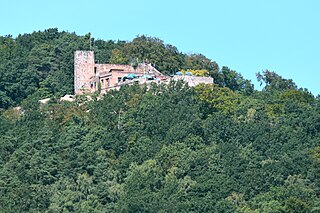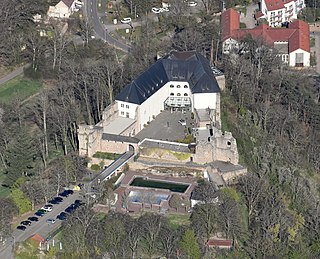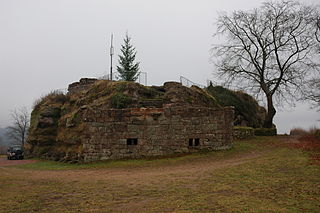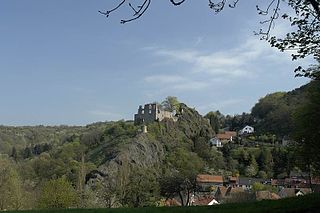
Battenberg Castle is a castle ruin near Battenberg in the county of Bad Dürkheim in the state of Rhineland-Palatinate, Germany.

Falkenburg Castle is a castle ruin overlooking the village of Wilgartswiesen in the Palatinate Forest in Rhineland-Palatinate, Germany. Like almost all castles in this region it was built on sandstone.

The Rietburg is a ruined hillside castle on the edge of the Palatinate Forest above the village of Rhodt in the county of Südliche Weinstrasse in the German state of Rhineland-Palatinate.

Blumenstein Castle is a castle ruin in the Palatinate Forest in Rhineland-Palatinate, Germany. According to the State of Rhineland-Palatinate, Blumenstein castle was probably constructed in the first half of the 13th century as part of a line of defensive castles along the Alsatian border.

The Hardenburg on the eastern edge of the Palatinate Forest near the Rhineland-Palatinate town of Bad Dürkheim is even as a ruin one of the mightiest castles of Palatinate. It was the residence of the Counts of Leiningen, who in 1725 moved to Schloss Dürkheim.

Spangenberg Castle is the partially rebuilt ruin of a rock castle in the German state of Rhineland-Palatinate. It lies in the Palatine Forest above the Elmstein valley near the village of Erfenstein, but is actually on the forest estates belong to the town of Neustadt an der Weinstraße, or more precisely, the village of Lachen-Speyerdorf. Together with the neighbouring castle of Erfenstein, it is linked to the legend of the Leather Bridge.

Rheingrafenstein Castle is a castle on a 136-metre-high (446 ft) porphyry rock formation, the Rheingrafenstein, known as Huhinstein a thousand years, on the river Nahe, opposite Bad Münster am Stein-Ebernburg in the district Bad Kreuznach.

Frankenstein Castle is a medieval fortification on a spur above the village of Frankenstein, Rhineland-Palatinate in the Palatinate Forest in Germany. Its name derives from the local House of Frankenstein.

Gräfenstein Castle is a ruined rock castle about 2 kilometres (1.2 mi) east of the village of Merzalben in the German state of Rhineland-Palatinate. It is in the county of Südwestpfalz within the Palatine Forest and is often called Merzalber Schloss. It is built on a rock plateau 12 metres (39 ft) high at an elevation of 447 metres (1,467 ft) above sea level.

The castles of Dahn, near the little town of Dahn in the German state of Rhineland-Palatinate, consist of three rock castles:

Grafendahn Castle lies in the southern Palatine Forest, the German part of the Wasgau region, just under 1 kilometre east of the small town of Dahn in the state of Rhineland-Palatinate.

Tanstein Castle is the ruin of a rock castle in the southern Palatine Forest, the German part of the Wasgau region. It lies just under a kilometre east of the small town of Dahn in the state of Rhineland-Palatinate.

Erfenstein Castle is a medieval spur castle in the German state of Rhineland-Palatinate. It lies within the Palatine Forest above the Elmstein Valley at 265 m above sea level (NN) in the vicinity of the hamlet of Erfenstein in the municipality of Esthal. Together with nearby Spangenberg Castle, it is linked to the legend of the Leather Bridge.

Altleiningen is a castle in the Palatinate Forest in Germany. It lies in the parish of Altleiningen in the county of Bad Dürkheim in the German state of Rhineland-Palatinate.

Scharfenberg Castle, is the ruin of a medieval rock castle in the Palatine Forest in the German state of Rhineland-Palatinate. It is situated above the small South Palatine town of Annweiler.

Lemberg Castle is a medieval castle on the territory of Lemberg in the county of Südwestpfalz in the German state of Rhineland-Palatinate.

Lindelbrunn Castle is the medieval ruin of a rock castle near the village of Vorderweidenthal in the county of Südliche Weinstraße in the German state of Rhineland-Palatinate.

Hohenecken Castle is the ruin of a spur castle from the Hohenstaufen era on the Schlossberg hill above the Kaiserslautern ward of Hohenecken in Rhineland-Palatinate, Germany. It is located at an elevation of 363 m above sea level (NN).

Falkenstein Castle is a ruined hill castle dating to the Middle Ages. It is situated above the eponymous village of Falkenstein on the Donnersberg, the highest point in the Palatinate region, which rises within the German state of Rhineland-Palatinate.

Old Wolfstein Castle, is a ruined hillside castle on the eastern slopes of the Königsberg at the narrowest point in the Lauter valley near Wolfstein in the county of Kusel in the German state of Rhineland-Palatinate.


















